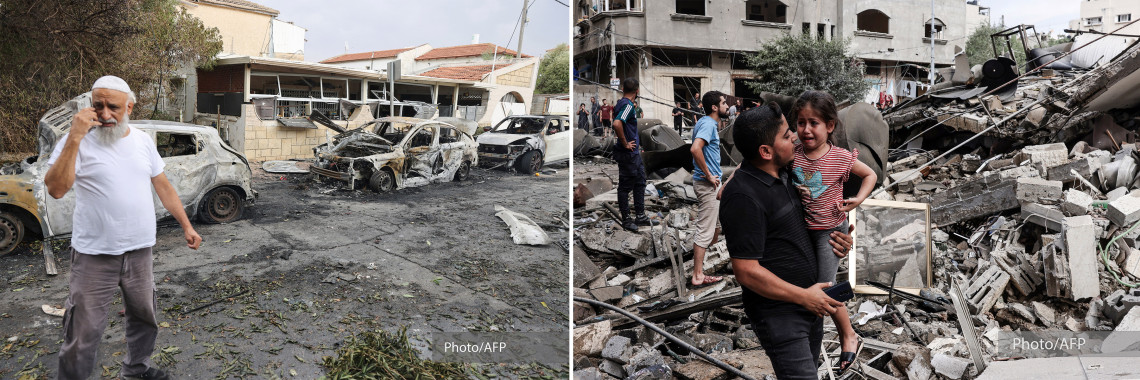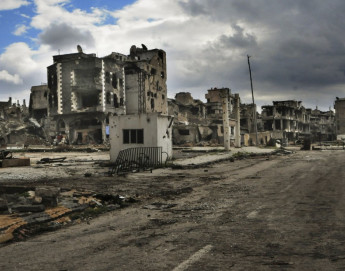
Frequently asked questions on ICRC’s work in Israel and the occupied territories

Updated 27/03/2024
The ICRC has been providing assistance to people affected by the conflict and violence in Israel and the Occupied Territories (ILOT) since 1967. This page is an effort to make information easily accessible to all those who feel like the ICRC can help them in some way. This page also addresses frequently asked questions about our work and international humanitarian law (IHL) following the intensification of armed violence in Israel and the occupied Palestinian territory on 7 October 2023.
The way we work
What does the ICRC do in Israel and the occupied territories?
In Israel and the occupied territories, (consisting of the occupied Palestinian territory of Gaza and the West Bank, and the Golan), the ICRC strives to make a difference in people's lives through its activities and programmes. We visit detainees, reunite families, support livelihood projects, and help improve access to essential services, like water and electricity. Above all, we stand up for people and promote their rights and dignity.
We have been present in Israel and the occupied territories since 1967 and work with the Palestine Red Crescent Society and Magen David Adom in Israel. The ICRC has offices in Tel Aviv, the West Bank and Gaza.
Here is a snapshot of our activities in the first six months of 2023.
What has ICRC's emergency response been since 7 October?
Thanks to decades of presence in Gaza, our teams present on the ground are ready to support essential infrastructure providing health care, water, and electricity.
In Gaza, the ICRC has over 100 staff, who have been working relentlessly since the escalation of the armed conflict to provide much-needed relief. Additionally, new staff -comprised of medical, surgical and weapon contamination experts- have rotated into Gaza. The team is currently supporting hospitals and delivering life-saving trauma surgery. They have also distributed essential household items to thousands of internally displaced people.
In Israel, our teams have been assisting with forensic equipment, and mental health support. We have offered any support or expertise that would benefit the authorities, within ICRC's mandate.
We continue to call for the immediate release of the hostages. Thanks to our neutral intermediary role, we have facilitated the release of 109 hostages. However, for those remaining in captivity, our call is very clear: we need to have access to them, assess their needs, and re-establish contact with their families. People who have been taken hostage need to be released. People detained must be treated humanely.
Is the ICRC more active in the occupied Palestinian territory than in Israel?
Our teams in the field continuously assess the humanitarian consequences of the conflict and strive to provide help based on the existing humanitarian needs. In the occupied Palestinian territory, the humanitarian needs far outweigh those in Israel: baselines related to unemployment rates and dependency on humanitarian assistance are clear indicators of this. Separately, the technical and financial capacity of Israel to respond to the needs of the Israelis far outweighs that of the Palestinian Authorities and Hamas.
The ICRC never replaces or duplicates the existing services, it responds to the needs that the responsible authorities are unable to cover. In the south of Israel, for example, our teams regularly visit communities affected by violence. The emergency response mechanisms in these communities are very strong. Nevertheless, we continue to monitor the situation and stand ready to provide support if we identify a need.
What would happen if the ICRC took sides and compromised its principles of neutrality and impartiality?
If the ICRC were to take sides it would lose the trust of these sides. Without this trust, we would not be able to continue carrying-out lifesaving operations and responding to the needs of the affected communities, detainees, families of missing persons and the sick. Our neutrality and principles are not always well understood, especially in situations where there are strong emotions involved. However, our neutrality and impartiality are critical to our ability to operate in any context.
Does the Red Cross consider religion when deciding where to provide humanitarian aid?
No, it does not. The ICRC is not a religious organization and only provides aid based on the existing humanitarian needs. As part of the International Red Cross and Red Crescent Movement, our humanitarian work is guided by fundamental principles that emphasize neutrality, impartiality, and independence. We do not engage in religious or political matters or take sides in any controversies. Our mission is solely focused on alleviating human suffering, providing aid to those in need, and upholding the principles of neutrality, impartiality, and independence in our humanitarian efforts. While some symbols associated with the Movement, such as the Red Cross and Red Crescent, may have historical connections to religious origins, the Movement itself is defined as a non-religious entity dedicated to humanitarian action and the protection of human life and dignity.
Take care before you share
If you come across content online that you believe to be false or misleading, you can report it directly to the social media platform.
You can also help slow the spread of misinformation by checking the veracity of questionable information before sharing it with others.
Read more: Debunking harmful narratives about our work in Israel and the occupied Palestinian territories
What the law says
Why does the ICRC consider Palestinian territory to be occupied, since Palestine was never a State?
Occupation is a matter of fact: a territory is considered occupied when it is placed under the authority of a hostile army. Whether the territory concerned is under the control of a sovereign on the eve of the commencement of an occupation is immaterial, and controversy in respect of Palestine's statehood has no bearing on this legal determination.
Since the 1967 international armed conflict between Israel and its neighboring States that triggered the application of the four Geneva Conventions of 1949, the Palestinian territory has been under the authority of the Israeli army. Thus, the ICRC considers the territories controlled by Israel as being under Israeli belligerent occupation, affirming the de jure applicability of the law of occupation (Hague Regulations of 1907 and the Fourth Geneva Convention of 1949). The application of the law of occupation is without prejudice to any underlying dispute concerning the sovereignty over the territory.
What is the status of the Gaza Strip under international law?
The ICRC considers Gaza to remain occupied Palestinian territory on the basis that Israel still exercises key elements of authority over the strip, including over its borders (airspace, sea and land - at the exception of the border with Egypt). Even though Israel no longer maintains a permanent presence inside the Gaza Strip, it continues to be bound by certain obligations under the law of occupation that are commensurate with the degree to which it exercises control over it.
What does IHL say about the protection of hospitals?
The laws of war prohibit direct attacks against hospitals and medical staff. They are specially protected under IHL.
That said, a hospital may become a legitimate military target if it contributes to specific military operations of the enemy and if its destruction offers a definite military advantage for the attacking side.
If there is any doubt, they cannot be attacked. Hospitals only lose their protection in certain circumstances - for example, if a hospital is being used as a base from which to launch an attack, as a weapons depot, or to hide healthy soldiers/fighters. And there are certain conditions too.
Before a party to a conflict can respond to such acts by attacking, it has to give a warning, with a time limit, and the other party has to have ignored that warning.
What is the status of hostages under IHL?
Hostages are people who, irrespective of their status, have been captured by a person or organization and who may be killed or injured if people do not do what that person or organization demands. Carrying out, or threatening to carry out, an act of hostage-taking during armed conflicts is prohibited under IHL.
If you want to know more: Frequently asked questions on ICRC and the hostages held in Gaza
What rules govern the transfer of weapons to a party to the armed conflict?
With a view to reducing human suffering, the Arms Trade Treaty (ATT) prohibits State Parties from authorizing the export, transit and other transfers of conventional arms, ammunition and related parts and components covered under the Treaty in the knowledge that they would be used to commit war crimes or other international crimes (Art 6). The ATT also prohibits States Parties from exporting weapons where there is an overriding risk that the supplied weapons could be used to commit or facilitate a serious violation of IHL (Art 7). Regional instruments impose similar restrictions.
All States, even those not party to the ATT, have an obligation to refrain from transferring weapons to a party to an armed conflict if there is a substantial or clear risk of encouraging, aiding or assisting in the commission of IHL violations. In addition, arms transferring States must do everything reasonably in their power to prevent and stop IHL violations committed by their arms trading partners (Art 1 common to the 1949 Geneva Conventions). States that supply weapons to a party to an ongoing armed conflict can be considered particularly influential in ensuring respect for IHL, owing to their ability to provide or withhold the means by which IHL violations may be committed. Refusing to transfer arms, or limiting or conditioning transfers, are practical means in the power of arms transferring States to prevent IHL violations.
Read more about understanding the Arms Trade Treaty from a humanitarian perspective.
What are the rules on sieges?
Sieges often have grave consequences for large numbers of civilians. To protect civilians, there are important rules in IHL. Crucially, civilians must be allowed to evacuate from a besieged area. Neither the besieging force nor the force under siege may force them to remain against their will.
Sieges may only be directed exclusively against an enemy's armed forces, and it is absolutely prohibited to shoot or attack civilians fleeing a besieged area. In addition, parties must comply with all the rules governing the conduct of hostilities. Constant care must be taken to spare civilians when putting a city under siege and attacking military objectives in the besieged area.
All feasible precautions must be taken to avoid or minimize incidental loss of civilian life, injury to civilians, and damage to civilian objects. IHL also prohibits starving the civilian population as a method of warfare. At the same time, although temporary evacuations may be necessary, and even legally required, sieges must not be used to compel civilians to permanently leave an area.
Read more on the protection of the civilian population during sieges
How are children protected?
In addition to the protection for civilians under the rules on the conduct of hostilities, IHL affords special respect and protection to children during armed conflicts. This includes access to food, water, healthcare, education, protection from family separation, and special safeguards during evacuations.
Children are seriously affected by fighting during war in cities, with severe impacts on their health, development and well-being. For example, due to children's unique anatomy and physiology, explosive devices designed to wound adult combatants can inflict severe and often lethal injuries on children. Children also risk losing contact or being separated from their families, for instance if they are hospitalized, or during evacuations, displacement and sheltering from attacks.
Finally, urban warfare denies or disrupts children's education, especially when schools are attacked, incidentally damaged, or used for military purposes. When schools are used as shelters, it also disrupts education. IHL contains provisions to ensure that students, teachers, and educational facilities are protected during armed conflicts so that education can continue.
What does IHL say about torture?
Torture and other forms of ill-treatment are absolutely prohibited everywhere and at all times. Both IHL and international human rights law (IHRL) complement each other in creating a comprehensive body of rules for the prevention and punishment of acts of torture and other forms of ill-treatment.
States have agreed that there can be no excuse for torture. The suffering caused by such practices may have profoundly disturbing effects on victims that can last for years.
What does IHL say about food security?
A recurring concern in conflict is acute food insecurity. IHL has important rules that can prevent a situation from developing into an extreme food crisis. For instance, parties to the conflict have the obligation to meet the basic needs of the population under their control.
In addition, IHL specifically prohibits the use of starvation of civilians as a method of warfare – a violation of which may amount to a war crime. Moreover, objects indispensable to the survival of the civilian population, such as foodstuffs, agricultural areas, crops, livestock, drinking water installations and supplies, and irrigation works, are specially protected.
They may not be the object of an attack, destruction, removal, or otherwise be rendered useless. Similarly, respect for other IHL rules can play an important role in preventing food insecurity, such as protection of the environment, limitations on sieges, and access to humanitarian relief.
How does IHL protect civilians and civilian objects against the danger of hostilities?
The IHL principles and rules that govern the conduct of hostilities aim to protect the civilian population from the effects of hostilities. It does so by striking a balance between military necessity and humanity, imposing prohibitions and restrictions on the weapons, means and methods of warfare that parties to the conflict may use.
The three fundamental principles of distinction, proportionality, and precautions are customary in nature and must be complied with in all circumstances by all parties - States and non-state armed groups alike - in all armed conflicts - both international and non-international armed conflicts.
According to the cardinal principle of distinction, parties to an armed conflict must at all times distinguish between civilians and combatants, and between civilian objects and military objectives.
IHL specifically prohibits attacks directed against civilians and against civilian objects, as well as indiscriminate attacks, namely those that strike military objectives and civilians or civilian objects without distinction, including area bombardment. Equally prohibited are acts or threats of violence the primary purpose of which is to spread terror among the civilian population, and the use of starvation of the civilian population as a method of warfare.
The principles of proportionality and precautions complement the principle of distinction by affording protection to civilians and civilian objects against the danger of being incidentally harmed by attacks against military objectives. While causing such harm is often unavoidable during armed conflict, IHL places a limit on the extent of incidental harm that is permissible by spelling out how military necessity and considerations of humanity must be balanced in such situations.
The rule of proportionality prohibits attacks that may be expected to cause excessive incidental civilian harm in relation to the concrete and direct military advantage anticipated.
Under the principle of precautions, in the conduct of military operations constant care must be taken to spare the civilian population, civilians and civilian objects. Given the significant risk of harm to civilians whenever executing an attack, IHL imposes detailed obligations to those planning, deciding on or carrying out attacks. In particular, all feasible precautions must be taken to
- Verify that targets are military objectives;
- avoid, and in any event to minimize, incidental loss of civilian life, injury to civilians and damage to civilian objects;
- assess whether the attack may be expected to violate the rule of proportionality;
- cancel or suspend an attack if it becomes apparent that it would violate the principles of distinction or the rule of proportionality;
- give effective advance warning of attacks which may affect the civilian population.
IHL also requires parties to the conflict to protect civilians and civilian objects under their control against the effects of attacks.
In cities, military and civilian people and objects are often intermingled. For parties involved in hostilities in urban or other populated areas, this intermingling presents important challenges, both militarily and in terms of avoiding civilian harm. Because urban warfare endangers civilians in ways particular to it, the protection afforded by the principles and rules of IHL is critical.
What are the rules regulating the use of weapons, including explosive weapons?
IHL imposes numerous prohibitions and restrictions on the development and use of specific weapons, under both treaty and customary law (see rules 70 to 86 of the ICRC customary IHL study). The use of all weapons, including those whose use is specifically restricted, must in any case comply with all the principles and rules governing the conduct of hostilities, including the prohibitions against direct, indiscriminate and disproportionate attacks, and the rules on precautions in attack (see above How does IHL protect civilians and civilian objects against the danger of hostilities?).
While there is no general prohibition under IHL against using heavy explosive weapons in populated areas, their use in such areas is very likely to have indiscriminate effects, and depending on the circumstances IHL rules may well prohibit such use. This underpins the long-standing call by the ICRC and the broader International Red Cross and Red Crescent Movement to all States and non-state armed groups parties to armed conflicts to avoid the use of heavy explosive weapons in populated areas. These weapons should not be used in populated areas unless sufficient mitigation measures can be taken to limit their wide area effects and the consequent risk of civilian harm.
The Political Declaration on Strengthening the Protection of Civilians from the Humanitarian Consequences arising from the use of Explosive Weapons in Populated Areas was adopted by more than 80 States in 2022. It is the first instrument of its kind committing States, among others, to review their military policy and practice in order to restrict, or refrain from, the use of explosive weapons in populated areas, where such use may cause civilian harm. When properly implemented, it can contribute significantly to alleviating civilian suffering and strengthening respect for IHL.
What does IHL say about the protection of critical civilian infrastructure?
Critical civilian infrastructure that enables the provision of essential services to civilians are in principle civilian objects, and as such as protected by all the IHL rules protecting the civilian population and civilian objects from the effects of hostilities. Importantly, this includes prohibitions against direct, indiscriminate and disproportionate attacks, and the rules on precautions in attack and against the effects of attack.
The services essential for the civilian population and other protected persons during armed conflict are interconnected and interdependent, which means the disruption of one can have domino or reverberating effects on others and result in multiple services being disrupted or even collapsing. For instance, electricity supply is needed to ensure the delivery of water and sanitation, solid waste disposal and the cold chain. Hospitals and food production and distribution capacities are then dependent on a reliable supply of safe water, sanitation, and electricity.
Attacks expected to damage critical infrastructure will likely affect a large part of the civilian population beyond the weapon's impact area and for a period well beyond the immediate aftermath of the attack. Such harm is relevant for both proportionality and precautions in attack insofar as it has a causal link to the attack and is reasonably foreseeable at the time of the attack.
IHL also affords special, heightened protection to certain types of critical infrastructure, notably hospitals and other medical facilities and transports, objects indispensable to the survival of the civilian population, and works and installations containing dangerous forces, to cultural property, and to the natural environment. Every specific protection regime is different, but it often entails protection against operations other than attacks, and some degree of protection even in the case where such objects would otherwise constitute military objectives.
More resources from international humanitarian law
- Frequently asked questions on the rules of war
- The protection of the civilian population during sieges
- The deadly legacy of explosive remnants of war
- Food security in times of armed conflict
- The protection of hospitals
- How humanitarian corridors work
- Humanitarian access in times of conflict
- Israel and the occupied territories: how international humanitarian law applies (podcast)
Read our latest Facts and Figures from 07 October to 29 February 2023
If you want to know more about the rules of war, watch this video
You can also find here:
- Frequently asked questions on ICRC and the hostages held in Gaza
- Frequently asked questions on ICRC’s work in Israel and the occupied territories in Arabic and Hebrew,
- Information for people affected by the conflict in Israel (available in Hebrew),
- Information for people affected by the conflict in Gaza and the West Bank (available in Arabic),
- and our Facts and Figures from 07 October to 14 December 2023


